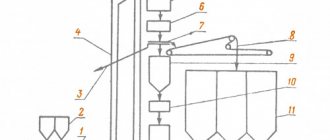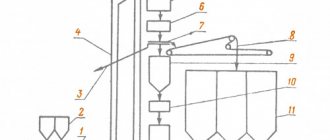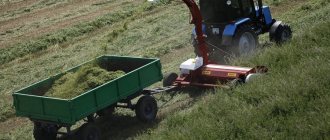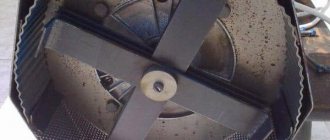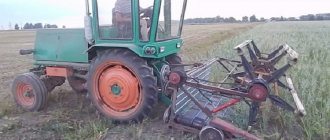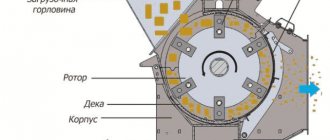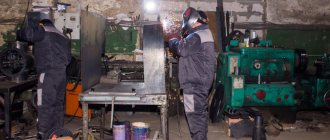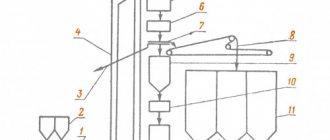The operation of an elevator is a complex process that involves the operation of many mechanisms.
Elevators play a large and important role in the agricultural sector, because the entire mass of delivered grain cannot be sent at once for storage or processing at enterprises, but here actions are carried out with grain, including post-harvest processing.
All manipulations carried out in it are aimed at ensuring its safety and improving its quality characteristics. All machines involved ensure the following work with grain:
- reception;
- cleaning, drying, disinfection;
- storage;
- movement within the complex;
- vacation (to designated points by rail, road or water transport).
And automation of the operation of a grain elevator optimizes the efficiency of controlling the stages of cleaning, drying, calibration, and organizing routes without the possibility of mixing different crops.
Types and scope of use of grain elevators
Depending on the volume of grain storage, elevators are divided into:
• procurement,
which are focused on receiving and cleaning grain from farms, its short- and medium-term storage with further shipment to larger facilities (intended for 15-100 thousand tons of grain);
• long-term storage elevators
– used for storing large quantities of grain (from 150 thousand tons), maintaining its condition and periodically shipping it for processing;
• production
– designed for 10-15 thousand tons of grain and focused on its rapid shipment into production and maintaining a supply of working material;
• transshipment (port)
– elevators, which are designed for receiving and transshipping grain with different shelf life, and the possibility of releasing it into wagons, ships, and vehicles.
Different elevators are designed and equipped with one or another equipment according to the specifics of grain storage and supporting operations. All this is determined during the preparation of the design assignment and is determined by local conditions and requirements for a particular object.
Sorting by optical characteristics
Optical sorting is undoubtedly a new, cutting-edge technology that is rapidly evolving. However, the industry already has significant experience with the use of optical sorters, which makes it possible to determine the boundaries of their appropriate use. An optical sorter is a machine that mainly uses differences in surface color as separation features and is therefore valuable because no other machine uses this feature. At the same time, it is necessary to clearly understand how well such a sign of separation corresponds to the purpose of purification.
A common mistake when using optical sorters is that they try to distinguish by the difference in color something that can easily be distinguished by simple and traditional cleaning methods, due to their high efficiency. Therefore, the use of optical sorters is not a replacement for traditional cleaning methods with alternative or more effective methods, but a rational addition to them. Based on practice, the use of optical sorters is advisable at the final cleaning operation of individual batches of seeds and finished products.
Elevator device
The elevator structure is a complex of silos, preparatory and transport systems, control facilities and internal logistics. A grain elevator is an industrial facility in which the set of equipment and the design of all systems are unified and aimed at solving the main task, which is to ensure the safety of grain within its standard condition. Most elevators also include functionally necessary equipment.
Reception systems and equipment
To unload grain into temporary containers, bunkers, pits, hydraulic lifts for cars, as well as pneumatic hoses for unloading wagons and ships are used. The composition of the equipment is determined based on logistics (in small farms it will be enough to equip the elevator with devices for unloading machines).
Equipment for cleaning and preparing grain
The technological chain of a grain elevator may include KZS and ZAV complexes as modular ready-made solutions. It is possible to install aspiration, cleaning and other equipment in separate lines. The grain elevator can accept both material that has undergone only initial cleaning, and work with ready-made grain of the required condition.
Internal technological transport of the elevator
The internal technological transport of a grain elevator is a set of equipment and machines used to move grain. As a rule, it consists of:
• horizontal and inclined scraper conveyors;
• bucket elevators used for raising grain;
• pneumatic transport systems;
• gravity flow systems with plugs, dampers and other devices necessary to control grain flows;
• conveyors and bag loading devices designed for feeding grain into silos;
• screw conveyors used to supply grain to equipment and unload silos.
Suction equipment
Based on the specific elevator unit, aspiration units with cyclones and cyclone batteries are used, which can separate dust and small particles from the air.
Market analysis: industry development rates
The practical implementation of a business project is impossible without a thorough preliminary analysis of the market situation and the local level of competition. It is necessary to study and analyze local offers of elevator services, identify a list of competing companies, determine the strengths and weaknesses of competitors in order to use the information obtained for effective participation in competition and accelerated entry into the local market.
The factor that determines the prospects of business in this branch of economic activity is the stable demand for agricultural products in Russia and neighboring countries. In addition, a novice entrepreneur should know that the activities of agricultural business projects are actively supported by modern government policy in this area. It should also be noted that there are ample opportunities for exporting agricultural products and the domestic sales market.
The principle of operation of elevators
An elevator is an industrial grain storage facility, in the design and arrangement of which all technological processes responsible for receiving, preparing, storing and unloading grain were taken into account. The principle of operation of the elevator is the step-by-step implementation of the following technological processes:
1. Grain reception
Can be carried out from any vehicle. In procurement elevators for farms, a vehicle unloading point into pits and bunkers is usually organized. Berths and railway lines can be designed at transshipment elevators.
2. Grain processing and preparation
Thanks to its design, the elevator can clean a grain heap, dry it in grain dryers, and also sort it by size, i.e. calibration. Based on a particular source of grain supply, ZAV and KZS complexes, mine grain dryers and aspiration units are used.
3. Storage
This is the main task of a grain elevator. The granary itself is designed on the basis of metal silos with internal and external support systems.
4. Grain shipment
An elevator is a logistics hub that is equipped with a set of tools used to release material on any scale, using conveyors, pneumatic hoses and bunkers for this purpose. The set of equipment is determined based on the amount of grain, as well as transport capabilities for unloading.
Elevators are designed to solve complex issues of grain storage. Their functions may vary depending on the specifics of logistics, grain material, location and connection to other objects.
Application of a vibro-pneumatic method for separating impurities
To separate heavy impurities and separate by specific gravity, a vibro-pneumatic method is used, which is implemented in stone pickers, pneumatic tables, concentrators, combiners and sieve machines. The process of separating the grain mass occurs by using an upward air flow in combination with vibrations of the sorting surface. With this method, particles of the grain mass, being in a fluidized state, experience repeated collisions between themselves and the sorting surface, which leads to their intensive self-sorting.
The separation is carried out in such a way that the lower layers, consisting of particles of higher density, are sifted through the sorting surface (concentrators, sieve machines) or directed along it in the opposite direction of the movement of particles with lower density (stone selectors, pneumatic tables). Concentrators, combiners and sieve machines are used in the production of flour, so further consideration of them within the framework of this work is not appropriate.
Stone separators are used to separate mineral impurities from the grain mass (pebbles, coarse sand, pieces of ore, slag, pieces of earth, etc.), they are characterized by high productivity, compact design and efficiency of 98-99%.
In pneumatic tables, grain can be divided into several fractions differing in density, and, if necessary, small impurities can be separated - weed seeds, broken grains of the main crop, etc. The efficiency of separation of pre-cleaned grain in concentrators when separating its heavy fraction is 60-80%. In addition, an additional 0.2-0.3% of waste and puny grain is released.
The main disadvantage of machines that implement the vibro-pneumatic separation method is the use of air in an amount of 450-600 m3 per 1 ton of grain, which is released into the environment after cleaning from dust. Therefore, a promising direction for improving such machines is the introduction of closed air movement into their design.
Elevator equipment
A modern grain elevator is a complex consisting of metal containers (silos into which grain prepared for storage is loaded). The dimensions of the silo are selected according to the standard elevator design, taking into account capacity, availability of free space, wind and seismic activity.
Silos for grain storage can be of the following types:
• flat-bottomed
(large granaries, which are designed for long-term storage of material with active cross-ventilation of the mass);
• with conical (conical) bottom
– designed for storing operational grain reserves, as well as grain that is intended for shipment or that has not gone through the entire preparation cycle for long-term storage.
The main difference between these two types of silos is not only the volume of grain storage. Flat-bottomed silos have ventilation ducts at the bottom and are mounted on a more durable solid foundation. To unload them, you will need spacious pits with high-performance conveyors. In turn, the last layer of grain from the bottom is unloaded using a radial screw conveyor.
Silos with a conical bottom are mounted on durable metal structures, they are almost suspended in order to create conditions for unloading grain through the outlet hatch by gravity. When designing such silos, the deformation load that occurs during grain exit from below is certainly taken into account.
How to open a granary: basic steps
After conducting analytical studies of the local market situation, the implementation of this business plan is carried out as follows.
First, you should select a suitable plot of land for the development and location of the elevator. It is necessary to take into account the nuances of the favorable location of the land, the distance of the enterprise from the location of competing companies, the pros and cons of lease land legal relations.
Next, you need to take care of arranging premises for storing grain crops and other agricultural raw materials that comply with state norms and standards. You should also be concerned with the implementation and safe commissioning of the necessary engineering networks and communications.
In order to realize a competitive advantage in the form of prompt deliveries of small and large quantities of raw materials and grain crops, it is recommended to organize your own courier service, abandoning the idea of using the services of third-party companies.
